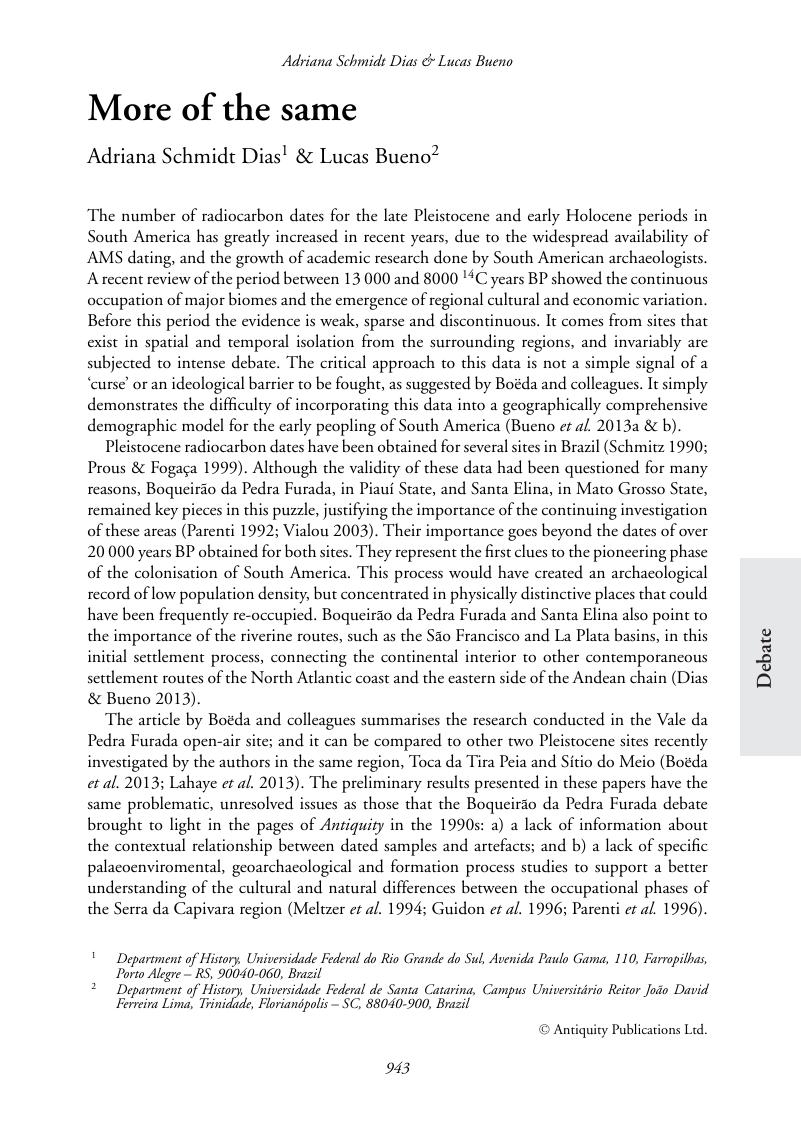Crossref Citations
This article has been cited by the following publications. This list is generated based on data provided by Crossref.
Bueno, Lucas
and
Dias, Adriana
2015.
Povoamento inicial da América do Sul: contribuições do contexto brasileiro.
Estudos Avançados,
Vol. 29,
Issue. 83,
p.
119.
Carandell Baruzzi, Miquel
2016.
The First American Scoop: The Pedra Furada Controversy in Newspapers (1978-2015).
Centaurus,
Vol. 58,
Issue. 3,
p.
239.
Mota, Leidiana
and
Scheel-Ybert, Rita
2019.
Landscape and firewood use in Toca do Boqueirão da Pedra Furada (Piauí, Brazil) during early and Mid-Holocene.
Journal of Archaeological Science: Reports,
Vol. 23,
Issue. ,
p.
281.
Dias, Adriana Schmidt
2019.
Um réquiem para Clovis.
Boletim do Museu Paraense Emílio Goeldi. Ciências Humanas,
Vol. 14,
Issue. 2,
p.
459.
Lourdeau, Antoine
2019.
A Serra da Capivara e os primeiros povoamentos sul-americanos: uma revisão bibliográfica.
Boletim do Museu Paraense Emílio Goeldi. Ciências Humanas,
Vol. 14,
Issue. 2,
p.
367.
Prates, Luciano
Politis, Gustavo G.
Perez, S. Ivan
and
Petraglia, Michael D.
2020.
Rapid radiation of humans in South America after the last glacial maximum: A radiocarbon-based study.
PLOS ONE,
Vol. 15,
Issue. 7,
p.
e0236023.
Villagran, Ximena S.
Hartmann, Gelvam A.
Stahlschmidt, Mareike
Heinrich, Susan
Gluchy, María F.
Hatté, Christine
Lahaye, Christelle
Griggo, Christophe
Pérez, Antonio
de Melo Ramos, Marcos Paulo
Straioto, Haruan
Santos, Janaina
Trindade, Ricardo I.F.
Strauss, André
Guidon, Niède
and
Böeda, Eric
2021.
Formation Processes of the Late Pleistocene Site Toca da Janela da Barra do Antonião – Piauí (Brazil).
PaleoAmerica,
Vol. 7,
Issue. 3,
p.
260.
Chatters, James C.
Potter, Ben A.
Prentiss, Anna Marie
Fiedel, Stuart J.
Haynes, Gary
Kelly, Robert L.
Kilby, J. David
Lanoë, François
Holland-Lulewicz, Jacob
Miller, D. Shane
Morrow, Juliet E.
Perri, Angela R.
Rademaker, Kurt M.
Reuther, Joshua D.
Ritchison, Brandon T.
Sanchez, Guadalupe
Sánchez-Morales, Ismael
Spivey-Faulkner, S. Margaret
Tune, Jesse W.
and
Haynes, C. Vance
2022.
Evaluating Claims of Early Human Occupation at Chiquihuite Cave, Mexico.
PaleoAmerica,
Vol. 8,
Issue. 1,
p.
1.





